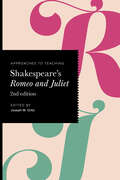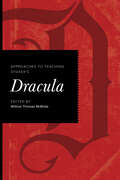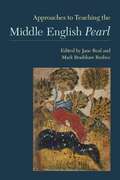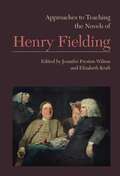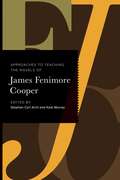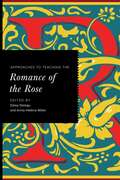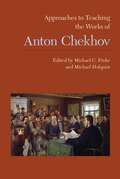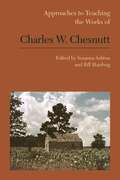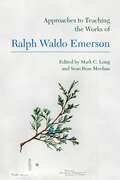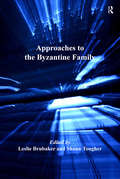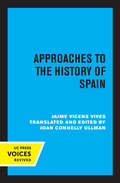- Table View
- List View
Approaches to Teaching Shakespeare's Romeo and Juliet (Approaches to Teaching World Literature #174)
by Joseph M. OrtizBy the time they encounter Romeo and Juliet in the classroom, many students have already been exposed to various, and sometimes incongruous, manifestations of Shakespeare's work. This volume makes a virtue of students' familiarity with the preconceptions, anachronisms, and appropriations that shape experiences of the work, finding innovative pedagogical possibilities in the play's adaptations and in new technologies that spark students' creative responses.The essays cover a wide area of concerns, such as marriage, gender, queer perspectives, and girlhood, and contributors embrace different ways of understanding the play, such as through dance, editing, and acting. The final essays focus on decolonizing the text by foregrounding both the role of race and economic inequality in the play and the remarkable confluence of Romeo and Juliet and Hispanic culture.
Approaches to Teaching Stoker's Dracula
by William Thomas McBrideThis volume helps teachers contextualize Bram Stoker's Dracula in its historical and cultural moment, considering psychology, technology, gender roles, colonialism, and anxieties about the other. It also situates the novel among the kindred texts that have proliferated since its publication, from film and television to the growing genre of vampire novels.Essays explore the novel in terms of medical humanities, contagion, and the gothic as well as ethnicity, identity, and race. Contributors analyze Dracula in the context of various ancient and modern cultural productions, including classical Indian aesthetics and African American vampire literature, and describe a broad range of classroom settings, including a technical university, a Hispanic-serving institution, and others.
Approaches to Teaching The Plum in the Golden Vase (Approaches to Teaching World Literature #159)
by Andrew SchonebaumThe Plum in the Golden Vase (also known as The Golden Lotus) was published in the early seventeenth century and may be the first long work of Chinese fiction written by a single (though anonymous) author. Featuring both complex structural elements and psychological and emotional realism, the novel centers on the rich merchant Ximen Qing and his household and describes the physical surroundings and material objects of a Ming Dynasty city. In part a social, political, and moral critique, the novel reflects on hierarchical power relations of family and state and the materialism of life at the time.The essays in this volume provide ideas for teaching the novel using a variety of approaches, from questions of genre, intertextuality, and the novel's reception to material culture, family and social dynamics, and power structures in sexual relations. Insights into the novel's representation of Buddhism, Chinese folk religion, legal culture, class, slavery, and obscenity are offered throughout the volume.
Approaches to Teaching the Middle English Pearl (Approaches to Teaching World Literature #143)
by Jane Beal and Mark Bradshaw BusbeeThe moving, richly allegorical poem Pearl was likely written by the anonymous poet who also penned Sir Gawain and the Green Knight. In it, a man in a garden, grieving the loss of a beloved pearl, dreams of the Pearl-Maiden, who appears across a stream. She teaches him the nature of innocence, God's grace, meekness, and purity. Though granted a vision of the New Jerusalem by the Pearl-Maiden, the dreamer is pained to discover that he cannot cross the stream himself and join her in bliss--at least not yet. This extraordinary poem is a door into late medieval poetics and Catholic piety.Part 1 of this volume, "Materials," introduces instructors to the many resources available for teaching the canonical yet challenging Pearl, including editions, translations, and scholarship on the poem as well as its historical context. The essays in part 2, "Approaches," offer instructors tools for introducing students to critical issues associated with the poem, such as its authorship, sources and analogues, structure and language, and relation to other works of its time. Contributors draw on interdisciplinary approaches to outline ways of teaching Pearl in a variety of classroom contexts.
Approaches to Teaching the Novels of Henry Fielding (Approaches to Teaching World Literature #139)
by Jennifer Preston Wilson and Elizabeth KraftThe works of Henry Fielding, though written nearly three hundred years ago, retain their sense of comedy and innovation in the face of tradition, and they easily engage the twenty-first-century student with many aspects of eighteenth-century life: travel, inns, masquerades, political and religious factions, the '45, prisons and the legal system, gender ideals and realities, social class.Part 1 of this volume, "Materials," discusses the available editions of Joseph Andrews, Tom Jones, Shamela, Jonathan Wild, and Amelia; suggests useful critical and contextual works for teaching them; and recommends helpful audiovisual and electronic resources. The essays of part 2, "Approaches," demonstrate that many of the methods and models used for one novel-- the romance tradition, Fielding's legal and journalistic writing, his techniques as a playwright, the ideas of Machiavelli-- can be adapted to others.
Approaches to Teaching the Novels of James Fenimore Cooper (Approaches to Teaching World Literature #172)
by Deepika Bahri Filippo MenozziA cosmopolitan author who spent nearly a decade in Europe and was versed in the works of his British and French contemporaries, James Fenimore Cooper was also deeply concerned with the America of his day and its history. His works embrace themes that have dominated American literature since: the frontier; the oppression of Native Americans by Europeans; questions of race, gender, and class; and rugged individualism, as represented by figures like the pirate, the spy, the hunter, and the settler. His most memorable character, Natty Bumppo, has entered into American popular culture.The essays in this volume offer students bridges to Cooper's novels, which grapple with complex moral issues that are still crucial today. Engaging with film adaptations, cross-culturalism, animal studies, media history, environmentalism, and Indigenous American poetics, the essays offer new ways to bring these novels to life in the classroom.
Approaches to Teaching the Romance of the Rose (Approaches to Teaching World Literature #170)
by Daisy Delogu and Anne-Hélène MillerOne of the most influential texts of its time, the Romance of the Rose offers readers a window into the world view of the late Middle Ages in Europe, including notions of moral philosophy and courtly love. Yet the Rose also explores topics that remain relevant to readers today, such as gender, desire, and the power of speech. Students, however, can find the work challenging because of its dual authorship by Guillaume de Lorris and Jean de Meun, its structure as an allegorical dream vision, and its encyclopedic length and scope. The essays in this volume offer strategies for teaching the poem with confidence and enjoyment. Part 1, "Materials," suggests helpful background resources. Part 2, "Approaches," presents contexts, critical approaches, and strategies for teaching the work and its classical and medieval sources, illustrations, and adaptations as well as the intellectual debates that surrounded it.
Approaches to Teaching the Works of Anton Chekhov (Approaches to Teaching World Literature #141)
by Michael C. Finke and Michael HolquistChekhov's works are unflinching in the face of human frailty. With their emphasis on the dignity and value of individuals during unique moments, they help us better understand how to exist with others when we are fundamentally alone. Written in Russia at the end of the nineteenth century, when the country began to move fitfully toward industrialization and grappled with the influence of Western liberalism even as it remained an autocracy, Chekhov's plays and stories continue to influence contemporary writers.The essays in this volume provide classroom strategies for teaching Chekhov's stories and plays, discuss how his medical training and practice related to his literary work, and compare Chekhov with writers both Russian and American. The volume also aims to help instructors with the daunting array of new editions in English, as well as with the ever-growing list of titles in visual media: filmed theater productions of his plays, adaptations of the plays and stories scripted for film, and amateur performances freely available online.
Approaches to Teaching the Works of C. P. Cavafy (Approaches to Teaching World Literature #175)
by Peter Jeffreys Demetres P. TryphonopoulosKnown as a preeminent poet of queer male desire, C. P. Cavafy lived most of his life as part of the Greek minority community in Alexandria, Egypt. He was inspired by the possibilities offered by peripheries, whether sexual, geographic, or historical. Volumes of his poems, widely translated into English, give anglophone readers access to his distinctive mixture of irony and tenderness, directness and subtlety.This volume will help instructors introduce students to Cavafy's works and explore them from many angles with the help of the extensive archives now available. Essays address teaching Cavafy both as a poetic historian of the Hellenistic, Roman, and Byzantine worlds and through the lens of postcoloniality. They also explore how he interpreted classical Greek works and how his work has been interpreted by composers, poets, and readers within and beyond Greece and the Greek diaspora.
Approaches to Teaching the Works of Charles W. Chesnutt (Approaches to Teaching World Literature #149)
by Susanna Ashton and Bill HardwigGrowing up in Cleveland after the Civil War and during the brutal rollback of Reconstruction and the onset of Jim Crow, Charles W. Chesnutt could have passed as white but chose to identify himself as black. An intellectual and activist involved with the NAACP who engaged in debate with Booker T. Washington and W. E. B. Du Bois, he wrote fiction and essays that addressed issues as various as segregation, class among both blacks and whites, Southern nostalgia, and the Wilmington coup d'état of 1898. The portrayals of race, racial violence, and stereotyping in Chesnutt's works challenge teachers and students to contend with literature as both a social and an ethical practice.In part 1 of this volume, "Materials," the editors survey the critical reception of Chesnutt's works in his lifetime and after, along with the biographical, critical, and archival texts available to teachers and students. The essays in part 2, "Approaches," address such topics in teaching Chesnutt as his use of dialect, the role of intertextuality and genre in his writing, irony, and his treatment of race, economics, and social justice.
Approaches to Teaching the Works of Christine de Pizan (Approaches to Teaching World Literature #148)
by Andrea TarnowskiA prolific poet and a protofeminist, Christine de Pizan worked within a sophisticated late medieval court culture and formed an identity as an authority on her society's preoccupations with religion, politics, and morality. Her works address various aspects of misogyny, the appropriate actions of rulers, and the ethical framework for social conduct. In addition to gaining a readership in fifteenth-century France, Christine's works influenced writers in Tudor England and were identified by twentieth-century readers as important contributions both to the emergence of a professional literary class and to the intellectual climate that gave rise to early modern Europe.Part 1 of this volume, "Materials," surveys the editions in Middle French, translations into modern French and English, and the many scholarly resources and critical reactions of the past fifty years. Part 2, "Approaches," provides insights into various aspects of Christine's works that can be explored with students, from considerations of genre and form to the themes of virtue, history, and memory. Teachers of French, English, world literature, and women's studies will find useful ideas throughout the volume.
Approaches to Teaching the Works of Inca Garcilaso de la Vega (Approaches to Teaching World Literature #169)
by Christian Fernández and José Antonio MazzottiThe author of Comentarios reales and La Florida del Inca, now recognized as key foundational works of Latin American literature and historiography, Inca Garcilaso de la Vega was born in 1539 in Cuzco, the son of a Spanish conquistador and an Incan princess, and later moved to Spain. Recalling the family stories and myths he had heard from his Quechua-speaking relatives during his youth and gathering information from friends who had remained in Peru, he created works that have come to indelibly shape our understanding of Incan history and administration. He also articulated a new American identity, which he called mestizo.This volume provides guidance on the translations of Garcilaso's writings and on the scholarly reception of his ideas. Instructors will discover ideas for teaching Garcilaso's works in relation to indigenous thought, European historiography, natural history, indigenous religion and Christianity, and Incan material culture. In essays informed by postcolonial and decolonial perspectives, scholars draw connections between Garcilaso's writings and contemporary issues like migration, multiculturalism, and indigenous rights.
Approaches to Teaching the Works of Ralph Waldo Emerson (Approaches to Teaching World Literature #155)
by Mark C. Long and Sean Ross MeehanA leader of the transcendentalist movement and one of the country's first public intellectuals, Ralph Waldo Emerson has been a long-standing presence in American literature courses. Today he is remembered for his essays, but in the nineteenth century he was also known as a poet and orator who engaged with issues such as religion, nature, education, and abolition.This volume presents strategies for placing Emerson in the context of his time, for illuminating his rhetorical techniques, and for tracing his influence into the present day and around the world. Part 1, "Materials," offers guidance for selecting classroom editions and information on Emerson's life, contexts, and reception. Part 2, "Approaches," provides suggestions for teaching Emerson's works in a variety of courses, not only literature but also creative writing, religion, digital humanities, media studies, and environmental studies. The essays in this section address Emerson's most frequently anthologized works, such as Nature and "Self-Reliance," along with other texts including sermons, lectures, journals, and poems.
Approaches to the Byzantine Family (Birmingham Byzantine and Ottoman Studies #14)
by Shaun Tougher Leslie BrubakerThe study of the family is one of the major lacunas in Byzantine Studies. Angeliki Laiou remarked in 1989 that ’the study of the Byzantine family is still in its infancy’, and this assertion remains true today. The present volume addresses this lacuna. It comprises 19 chapters written by international experts in the field which take a variety of approaches to the study of the Byzantine family, and embrace a chronological span from the later Roman to the late Byzantine empire. The context is established by chapters focusing on the Roman roots of the Byzantine family, the Christianisation of the family, and the nature of the family in contemporaneous cultures (the late antique west and the Islamic east). Key methodological approaches to the Byzantine family are highlighted and discussed, in particular prosopographical and life course approaches. The contribution of hagiography to the understanding of the Byzantine family is analysed by several authors; other chapters on the family and children in art and on the archaeology of the Middle Byzantine house explore the material evidence that can shed light on the Byzantine family. Overall, the diversity of families that existed in Byzantium (blood, fictive, metaphorical) is emphasised, and chapters consider the specific cases of ascetic, monastic, aristocratic and peasant families, as well as the imperial family, which is illuminated by the comparative case of a Caliphal family. The volume is topped and tailed by a Preface and an Afterword by the editors, which address the state of the field and consider the way ahead. Thus the volume is vital in putting the subject of the Byzantine Family in sharp focus and setting the research agenda for the future.
Approaches to the Evolution of Language: Language Evolution
by Rudolf BothaHow can we unravel the evolution of language, given that there is no direct evidence about it? Rudolf Botha addresses this intriguing question in his fascinating new book. Inferences can be drawn about language evolution from a range of other phenomena, serving as windows into this prehistoric process. These include shell-beads, fossil skulls and ancestral brains, modern pidgin and creole languages, homesign systems and emergent sign languages, modern motherese, language use of modern hunter-gatherers, first language acquisition, similarities between language and music, and comparative animal behaviour. The first systematic analysis of the Windows Approach, it will be of interest to students and researchers in many disciplines, including anthropology, archaeology, linguistics, palaeontology and primatology, as well as anyone interested in how language evolved.
Approaches to the History of Spain
by Jaime Vicens VivesThis title is part of UC Press's Voices Revived program, which commemorates University of California Press’s mission to seek out and cultivate the brightest minds and give them voice, reach, and impact. Drawing on a backlist dating to 1893, Voices Revived makes high-quality, peer-reviewed scholarship accessible once again using print-on-demand technology. This title was originally published in 1970.
Approaching Architecture: Three Fields, One Discipline
by Miguel GuitartThe study of the architectural discipline suffers from an increasing disconnect between its teaching and its professional practice. In this edited collection, 18 architectural voices address this disconnect by reflecting on the ways in which they exercise the architectural discipline in three ways: research, teaching, and practice. This book argues that the totality of activities encompassed by the architectural profession can be best fulfilled when reconsidering the critical interactions between these three fields in the everyday exercise of the profession. Split into three parts, "Architecture as Research," Architecture as Pedagogy," and "Architecture as Practice," each section focuses on one of these three dimensions while establishing continuity with the other two. In doing so, the book not only favors a more fulfilling interaction between academia and the profession but also reinforces the implementation of design theory and research in everyday teaching and practice. The contributions come from 18 teams of architects operating from geographically diverse locations, including Pezo von Ellrichshausen in Chile, Kengo Kuma & Associates in Japan, Barclay & Crousse in Peru, Shift in Iran, Heinrich Wolff in South Africa, and People’s Architecture Office in China, opening the design conversation to larger contexts and framing continuity and inclusion in time. Written for students, instructors, and practitioners alike, the inspiring reflections in this volume encourage readers to grow as architects and play an instrumental role in transforming the built environment.
Approaching China's Pharmaceutical Market: A Fundamental Guide to Clinical Drug Development
by Ming Q. LuThis authoritative volume examines the major laws, regulations and guidelines related to pharmaceutical product development in China. With a focus on patent, clinical and registration strategies, the book helps Western companies introduce their clinical drugs to the Chinese market, determine a strategic path and bridge the gap for regulatory and legal differences between China and the Western world. For a better understanding of the drug registration process, it explores the differences between the China Food and Drug Administration (CFDA)--including its regulations and registration procedures--and those of the Western world. The volume discusses disparities between China's application requirements compared to Western standards to make it easier for companies to prepare their application packages. It also provides detailed commentary on CFDA guidelines in reference to clinical trial (IND) and market application (NDA) requirements. Overall, this book offers guidance for Western companies aspiring to expand into China's pharmaceutical market in hopes that they may gain a fundamental understanding of its rules and complexities in order to ensure a smooth transition and prevent future issues.
Approaching Civil War and Southern History
by William J. Cooper Jr.Initially published between 1970 and 2012, the essays in Approaching Civil War and Southern History span almost the entirety of William J. Cooper’s illustrious scholarly career and range widely across a broad spectrum of subjects in Civil War and southern history. Together, they illustrate the broad scope of Cooper’s work. While many essays deal with his well-known interests, such as Jefferson Davis or the secession crisis, others are on lesser-known subjects, such as Civil War artist Edwin Forbes and the writer Daniel R. Hundley. In the new introduction to each chapter, Cooper notes the essay’s origins and purpose, explaining how it fits into his overarching interest in the nineteenth-century political history of the South. Combined and reprinted here for the first time, the ten essays in Approaching Civil War and Southern History reveal why Cooper is recognized today as one of the most influential historians of our time.
Approaching Democracy (6th edition)
by Larry Berman Bruce Allen MurphyApproaching Democracy addresses the evolving nature of the American experiment in democratic government. It teaches students the theory and the basics of American political science, the political history of this nation, and provides the critical thinking skills needed to analyze these evolving relationships.
Approaching Historical Sources in their Contexts: Space, Time and Performance (Routledge Guides to Using Historical Sources)
by Sarah Barber Corinna M. Peniston-BirdIn Approaching Historical Sources in Their Contexts, 12 academics examine how space, time and performance interact to co-create context for source analysis. The chapters cover 2000 years and stretch across the Americas and Europe. They are grouped into three themes, with the first four exploring aspects of movement within and around an environment: buildings, the tension between habitat and tourist landscape, cemeteries and war memorials. Three chapters look at different aspects of performance: masque and opera in which performance is (re)constructed from several media, radio and television. The final group of chapters consider objects and material culture in which both spatial placement and performance influence how they might be read as historical sources: archaeological finds and their digital management, the display of objects in heritage locations, clothing, photograph albums and scrapbooks. Supported by a range of case studies, the contributors embed lessons and methodological approaches within their chapters that can be adapted and adopted by those working with similar sources, offering students both a theoretical and practical demonstration of how to analyse sources within their contexts. Drawing out common threads to help those wishing to illuminate their own historical investigation, this book encourages a broad and inclusive approach to the physical and social contexts of historical evidence for those undertaking source analysis.
Approaching Pipe Rolls: The Thirteenth Century (Approaching Medieval Sources)
by Richard CassidyThis is the first study specifically concerned with thirteenth-century pipe rolls and shows how pipe rolls were compiled, what they contain, and how to read them. These records of English government finance were produced annually. They list debts owed to the government, by the sheriffs of each county, by manors and boroughs, and by individuals for taxes, fines and judicial penalties. They also list the payments made, sometimes in cash to the treasury, sometimes for building works, fees for royal employees and relatives, the provision of castles, and much more. The rolls are an essential source for administrative history, and provide detailed information for family and local historians. All the rolls are now readily available, either in print or online, but they are at first sight difficult to understand. This book shows how the rolls evolved in the course of the century and serves as a guide for beginners, armed with some basic Latin, who want to explore these records. As well as explaining the conventions of dates, numbers, abbreviations, monetary units and so on, it illustrates the material to be found in pipe rolls by a detailed examination of a single roll.
Approaching Recent World History Through Film: Context, Analysis, and Research
by Scott C.M. BaileyApproaching Recent World History Through Film: Context, Analysis, and Research explores the relationships between twentieth-century world history and film by providing analysis of a diverse range of films organized by global history topics, including war and conflict, decolonization, political economy, and long-distance travel. This insightful text describes how to analyze films as original historical sources and how to carry out research projects using films. The text provides guidance on the types of world history films, their conventions, and how to analyze the historical arguments in movies. Scott C.M. Bailey incorporates in-depth discussions of the historical content and context of a wide range of international films connected with important twentieth-century global history topics. The book also offers many prompts for discussion, historical timelines, and suggestions for further reading and viewing, as well as instructions on how to construct research papers and projects which employ the use of films as historical sources. This book will be of interest to students in world history and film history courses.
Approaching Records of the Household and Wardrobe: The Royal Accounts of Thirteenth-Century England (Approaching Medieval Sources)
by Abigail S. ArmstrongRecords of the household and wardrobe are important sources for understanding English royal medieval government. This book outlines their functions, organisation and development, along with the activities and accounts of the various officials and departments charged with their undertaking.The household was the political centre, encompassing a variety of departments catering to the day-to-day needs of the royal family and the court. The wardrobe was originally the location where cloth and other precious commodities were stored. Still, it took on increasing importance over the thirteenth century as the key financial and administrative office that itinerated alongside the king. This overview of the different types of household and wardrobe accounts and their contents demonstrates the wealth of information contained within these records. Conventions of language, abbreviations, money, numbers and dates are also explained. The two case studies illustrate how a household diet account and a wardrobe jewel account can be used to elucidate the actions and agency of Queens Eleanor of Provence and Margaret of France.As an introduction to the thirteenth-century household and wardrobe and their records, this book is an excellent guide for students and researchers who wish to use these documents in their research.
Approaching Social Hierarchies in Byzantium: Dialogues Between Rich and Poor (Birmingham Byzantine and Ottoman Studies)
by Anna C. Kelley Flavia VanniUtilising new methodological approaches to understanding not only the poor as a social and economic group but also of the internal means of stratification which informed social organisation within local communities, this book looks at the place of the poor within the multi-layered hierarchies of Byzantine society using evidence from archaeology, art, architecture, as well as narrative, theological, and legal texts. Rather than treating the different levels of society independently, it looks at the social interactions which replicated and reinforced hierarchies but were also subject to negotiation within local communities. Fifteen leading Byzantine scholars discuss and analyse the topic of social hierarchies in the Byzantine Empire, covering topics such as working lives, the material world, the stratification of space, and philanthropy and social obligation.The book will appeal to scholars and students alike interested in identity formation and expression in the Byzantine provinces, as well as those researching the social history of the poor in Byzantium, and the mechanisms of hierarchies, social marginalisation, and oppression.
